2.5 Technology Roadmapping
2.5.1 Introduction
An organization involved in product development faces a number of challenges related to its future. One of the most critical tasks is to define short-term and long-term product strategies that can be transformed into specific plans. To understand which products and technologies have to be planned for future development, especially within the long term, organizations need to forecast the evolution of their products. Any product or technology is created to meet certain needs and demands of the person or system for which it is to be developed. No technical product is developed to exist independently of the context in which it is supposed to be used: A product always delivers a function or a number of functions requested by its surrounding systems or environment. For instance, a battery is developed to provide electronic and electric devices with energy, and a flashlight's purpose is to deliver a function targeted at a higher system: a human being who wants to use the flashlight to illuminate a certain area of space.
To stay innovative, a company that produces flashlights has to therefore continuously follow the evolution of three areas: the (1) evolution of human or societal needs with respect to the functionality of devices producing light, (2) evolution of technologies that make it possible to create flashlights to meet these particular needs better, and (3) evolution of all competitive businesses that produce flashlights. In a modern global economy, ignoring just one of these areas will undoubtedly reduce the company's chances to survive and grow.
Understanding evolution means comprehending interrelations that exist between three large categories of knowledge related to a specific product: evolution of market, evolution of technology, and evolution of business. None of these areas is static; they are in continuous development.
It is also important to understand a difference between a technology and a product. A product is a technical system composed of a number of components that deliver specific functionality. A technology is a process that enables producing this functionality. For instance, a lamp can be considered a product, and a process of generating light on the basis of passing electric current through a metal wire that heats the wire and thus produces light can be considered a technology. It is obvious that a product might integrate many different subsystems that are built upon different technologies. A process of creating electric current and a process of generating light are two separate technologies. If we look at a mobile phone, we will see hundreds of enabling technologies that make it possible to create the needed functionality of its parts and components.
In turn, each subsystem of a mobile phone can be considered a separate product. However, the same functionality can be achieved on the basis of different technologies. For instance, a function of generating light can be obtained through heating metal wire, through laser radiation, or through the effect of electroluminescence in semiconductors. A particular type of technology can be described by a more general term, for example virtual reality. Sometimes the name of a technology can coincide with the name of a product if this product is used as a subsystem. For example, the term photo sensor might indicate a technology of capturing images by a light-sensitive matrix and converting captured information to digital form.
2.5.2 Technology Roadmaps
There are two major groups of factors that drive product evolution:
Both technology and market are spaces with many variables. How does one successfully identify what comes next? What products will be successful? And, more importantly, what products will these be? To plan feasibly, one should be aware of the current level of market needs and business developments. However, that is not enough. To make a long-term forecast that can result in a specific product development plan, we need to know what technologies can be used to improve existing products or develop new ones. Technology roadmapping addresses this issue.
The technology roadmap (TRM) introduces connections between identified market needs and trends with existing and emerging technologies for a specific industry sector to improve existing and develop new products. Technology roadmaps provide a graphical framework for exploring and communicating strategic plans. They comprise a multilayered, time-based chart that visually links market, product, and technology information and represents their evolutions within a selected time interval, enabling market opportunities and technology gaps to be identified. Originally, technology roadmapping was introduced by Motorola in the 1980s (Willyard and McClees, 1987).
TRMs can be used in various contexts (Garcia and Bray, 1997). Primarily, they are used in strategic product planning, research planning, business planning, intellectual property creation, and protection. Typically organizations create and use TRMs in two cases:
A typical TRM chart for both cases is shown in Figure 2.5.1. It consists of four layers:
For example, if a strategic emerging TRM for mobile wireless communication were created in 1991, its simplified version could look like the one shown in Figure 2.5.2. Such a roadmap was never created at that time; the purpose of this example is to better explain the paradigm of technology roadmapping and show what the final roadmap representing a long-term plan can look like. The gradient of the bars representing technology maturity is shown in an arbitrary form for illustrative purposes only.
Figure 2.5.1 Time-based layered chart in a typical TRM
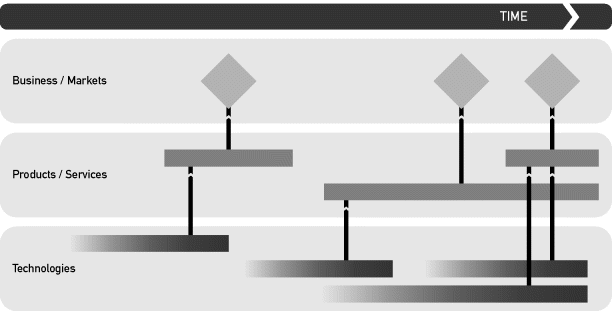
Figure 2.5.2 A TRM for a wireless mobile communication. Please note that this TRM has been made in 1991
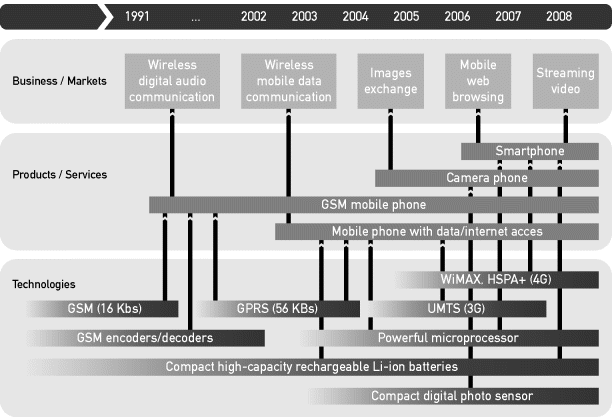
Note that it is extremely difficult to plan for almost 20 years ahead because certain technologies might not be available yet and new inventions that would influence the development of new products or their features are still to be created.
The diagrams shown in Figures 2.5.1 and 2.5.2 are the most simplified examples of TRM. TRM can include different layers in addition to these four layers. For instance, the following layers can be added:
- The vision layer represents change or updates of the vision of the organization.
- Market niches identify application areas for each product.
- Internal and external resources are needed to achieve each step of the plan for both technology and product development. This layer might comprise financial, technical, labor, and any other type of resources.
- R&D programs are needed to mature the needed technologies and integrate technologies to products.
- Integration activities are done with partners, suppliers, and customers.
There is no unified approach to developing roadmaps. Instead, each organization that develops TRMs uses the best practices and methods available in the organization or outside and can be highly customizable (Phaal, Farrukh, and Probert, 2004).
TRMs are very flexible, and any important information that can influence the proper planning of future products, technologies, and activities might be added. In addition, each bar representing a technology or a product can be further decomposed to more specific components. For instance, a camera phone (mentioned in Figure 2.5.2) might be referred to a broader list of technologies, such as image-processing software, data storage, lens, shooting parameters control, and so forth. For this reason, to avoid the growth of complexity of a TRM, a subsystem of a more complex system can be separated into another TRM. For instance, the evolution of data storage for mobile wireless communication might require a separate TRM. However, this separate TRM must still be connected with the main TRM.
2.5.3 Technology Readiness Levels
One of the major challenges in strategic emerging roadmapping is to recognize and identify emerging technologies in a timely way. Emerging technologies are those technologies that are still under development and have not reached a point yet when they can be used for creating new products or new product features. The only viable way to know what technologies might be used in the future is to continuously monitor these technologies in fields that might be related to a specific product category (or family). In the 1990s, NASA adopted a scale with nine levels that gained widespread acceptance across industry and remains in use today (Mankins, 1995). The scale includes the following technology readiness levels (TRLs):
- TRL 1: Basic scientific principles observed and reported. This is the lowest level of technology maturity.
- TRL 2: Basic technology concept and/or application formulated. At this level, the future application of the technology is still speculative.
- TRL 3: Analytical and experimental critical function and/or characteristic proof-of-concept. This step includes physical validation of the technology concept, primarily in the laboratory environment.
- TRL 4: Component and/or breadboard validation in the laboratory environment. This step extends checking against the physical validity of a concept, but is still in the laboratory environment.
- TRL 5: Component and/or breadboard validation in a relevant environment. This step provides validation of the technology concept in a realistic environment.
- TRL 6: System or subsystem model or prototype demonstration in a relevant environment. This step requires the development of a prototype of a future product and proof of its feasibility in a realistic environment.
- TRL 7: System prototype demonstration in a space environment. This step is specific to space missions.
- TRL 8: Actual system completed and “flight-qualified” through test and demonstration.
- TRL 9: Actual system “flight proven” through successful mission operations. This step involves the elimination of all errors in a product found at the previous step.
These TRLs can be used to evaluate the readiness and maturity of any technology and its degree of applicability in forecasted products. TRLs do not depend on financial, business, or market data used in TRM; they only focus on evaluating the physical and practical validity of a technology concept.
It is obvious that for a short-term product-planning TRM, only those technologies that are already proven in a realistic environment have to be chosen (TRLs 6–9). For a long-term strategic emerging TRM, lower TRLs can be considered too.
It is also crucial to estimate properly a current technology readiness level and how much time it might take to reach TRL 9, when the technology becomes mature and can be used in a new product. Such estimations are often performed by independent science and technology experts. Large companies that have extensive R&D divisions often prefer to develop such core technologies in-house (Figure 2.5.3). Many large industrial companies invest to groups performing basic research and cooperate with universities and various academic organizations.
Figure 2.5.3 A “thermometer” of technology readiness levels (TRLs) mapped to technology development phases
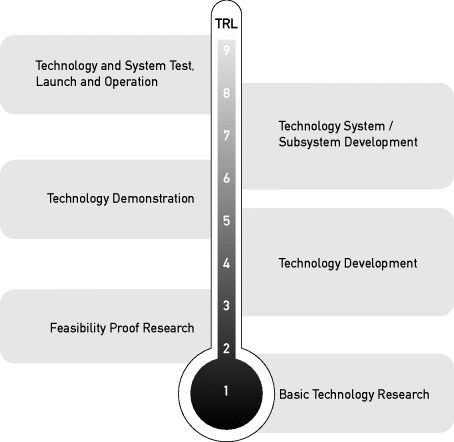
2.5.4 TRM Process
There are three phases of the TRM process identifying the following:
The process of creating TRM is highly iterative. It is performed in both top-down and bottom-up manners. A TRM process integrates both technology push and technology pull; therefore, after each phase of the TRM process is completed as a “first draft,” information gathered during the next phase can be used to introduce changes and modifications to the information gathered during the previous phase. Often, completely new information can be introduced; for instance, finding a new technology can lead to identifying a new market opportunity by creating a new product.
To properly prepare and finalize TRM, preparation and assessment activities are required. Once created and approved, TRM must be reassessed and updated regularly to avoid wrong investments, or add new technologies or the results of market studies that were omitted in the original and follow-up versions. Figure 2.5.4 represents all these activities, including a TRM process (stage 2).
Figure 2.5.4 A general process including TRM
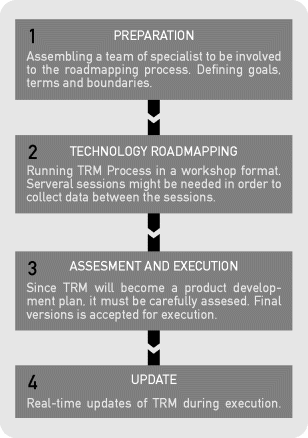
Preparation and analytical studies (phases 1 and 2 of the process described in Figure 2.5.3) can take time before one starts the first workshop on visualizing TRM. All findings during these stages are recorded in a document or in a number of documents that will accompany a created visual TRM. This document usually contains detailed descriptions of the follows:
- Results of market studies and vision.
- Future expected product features.
- Emerging technology readiness levels.
- Argumentations of decisions.
- Risks.
- Future collaborations.
- Estimated investments.
Today a number of software tools exist to support TRM. However, large organizations often prefer to develop their own tools adapted to their needs and goals. These tools can be integrated with other documents created by an organization for different purposes.
2.5.5 Benefits from TRM
In summary, TRM:
- Provides a visual framework for integrated product and technology planning.
- Helps with establishing the monitoring of key and critical technologies.
- Establishes a plan of key activities within a relatively long term.
- Visualizes critical information along a timeline.
- Identifies technology gaps.
- Helps with defining innovation strategies.
- Improves communication among different parties involved in business, technology, and product development.
- Improves decision making by bringing together critical issues along different activities.
- Identifies needed collaboration and cooperation activities organization-wide and with third parties that will be needed to realize technology and product plans.
- Helps with identifying resources, cost, and time targets.
- Helps to reduce short- and long-term risks.
TRM can be considered a part of technology foresight activities. It is a useful tool to identify business opportunities and to plan diverse joint activities across different units and groups in an organization.
2.5.6 Application of TRM
In 2008, master's-level students Erkel and Reilink developed the living cubes concept shown in Figure 2.5.5. Living cubes is a modular lighting system with interactive tiles that react to the environment in public spaces like, for instance, parks or shopping malls. In this project a TRM was developed for various technologies that could be applied in lighting products. This TRM is shown in Figure 2.5.6.
Figure 2.5.5 An impression of living cubes by Erkel and Reilink (2008)
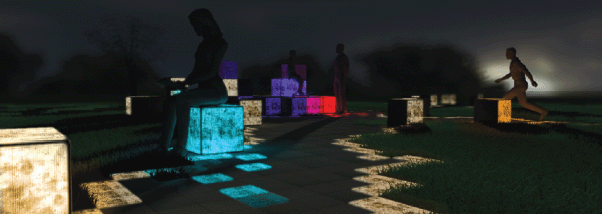
Figure 2.5.6 A technology roadmap made in the framework of living cubes by Erkel and Reilink (2008)

The interactive tiles with LED lights are all connected with each other to one central central processing unit (CPU) tile that processes all data to decide which tiles emit a certain color of light with a certain intensity. The living cubes concept has different functionalities during day and night. During day, the only functionality is decoration: making a public space interactive and personal. During night, the decorative functions remain and additionally lighting and security functions become active.
All light-emitting tiles have one or more light sensors (depending on the size of a tile) that can detect an object or person standing on top of the tile. When a tile detects a person, it sends a signal to the CPU tile that decides the appropriate reaction. All kinds of configurations can be created with different interactions. The following interactions are integrated in this concept:
